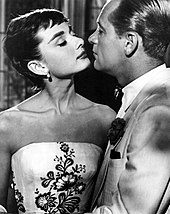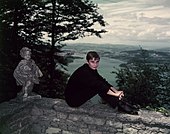Audrey Hepburn
Her last recorded performances were in the 1990 documentary television series Gardens of the World with Audrey Hepburn, for which she won a Primetime Emmy Award for Outstanding Individual Achievement – Informational Programming.
[9] At age 19, she married Jonkheer Hendrik Gustaaf Adolf Quarles van Ufford – an oil executive based in Batavia, Dutch East Indies, where the couple subsequently lived.
She had begun taking ballet lessons during her last years at boarding school, and continued training in Arnhem under the tutelage of Winja Marova, becoming her "star pupil".
In October 1945, a letter from Ella asking for help was received by Micky Burn, a former lover and British Army officer with whom she had corresponded while he was a prisoner of war in Colditz Castle.
After she was told by Rambert that despite her talent, her height and weak constitution (the after-effect of wartime malnutrition) would make the status of prima ballerina unattainable, she decided to concentrate on acting.
[55] After being spotted by the Ealing Studios casting director, Margaret Harper-Nelson, while performing in Sauce Piquante, Hepburn was registered as a freelance actress with the Associated British Picture Corporation (ABPC).
She appeared in the BBC Television play The Silent Village,[56] and in minor roles in the films One Wild Oat, Laughter in Paradise, Young Wives' Tale, and The Lavender Hill Mob (all 1951).
Coincidentally, French novelist Colette was at the Hôtel de Paris in Monte Carlo during the filming, and decided to cast Hepburn in the title role in the Broadway play Gigi.
On 18 September 1951, shortly after Secret People was finished but before its premiere, Thorold Dickinson made a screen test with the young starlet and sent it to director William Wyler, who was in Rome preparing Roman Holiday.
She exhibited her dancing abilities in her debut musical film, Funny Face (1957), wherein Fred Astaire, a fashion photographer, discovers a beatnik bookshop clerk (Hepburn) who, lured by a free trip to Paris, becomes a beautiful model.
Capote disapproved of many changes that were made to sanitise the story for the film adaptation, and would have preferred Marilyn Monroe to have been cast in the role, although he also stated that Hepburn "did a terrific job".
The same year, Hepburn also starred in William Wyler's drama The Children's Hour (1961), in which she and Shirley MacLaine play teachers whose lives are destroyed after two pupils accuse them of being lesbians.
[87] Hepburn next appeared opposite Cary Grant in the comic thriller Charade (1963), playing a young widow pursued by several men who chase after the fortune stolen by her murdered husband.
The 59-year-old Grant, who had previously withdrawn from the starring male lead roles in Roman Holiday and Sabrina, was sensitive about his age difference with 34-year-old Hepburn, and was uncomfortable about the romantic interplay.
Critic Bosley Crowther was less kind to her performance, stating that, "Hepburn is cheerfully committed to a mood of how-nuts-can-you-be in an obviously comforting assortment of expensive Givenchy costumes.
"[90] Although filmed in the summer of 1962 before Charade, Hepburn reunited with her Sabrina co-star William Holden in Paris When It Sizzles (1964), a screwball comedy in which she played the young assistant of a Hollywood screenwriter, who aids his writer's block by acting out his fantasies of possible plots.
[91] Dubbed "marshmallow-weight hokum" by Variety upon its release in April,[92] the film was "uniformly panned"[91] but critics were kinder to Hepburn's performance, describing her as "a refreshingly individual creature in an era of the exaggerated curve".
[93] Soundstage wrote that "not since Gone with the Wind has a motion picture created such universal excitement as My Fair Lady",[70] although Hepburn's casting in the role of Cockney flower girl Eliza Doolittle was a source of dispute.
Crowther wrote that, "The happiest thing about [My Fair Lady] is that Audrey Hepburn superbly justifies the decision of Jack Warner to get her to play the title role.
I went into rebel country and saw mothers and their children who had walked for ten days, even three weeks, looking for food, settling onto the desert floor into makeshift camps where they may die.
Her long-time friend, fashion designer Hubert de Givenchy, arranged for socialite Rachel Lambert "Bunny" Mellon to send her private Gulfstream jet, filled with flowers, to take Hepburn from Los Angeles to Geneva.
Maurice Eindiguer, the same pastor who wed Hepburn and Mel Ferrer and baptised her son Sean in 1960, presided over her funeral, while Prince Sadruddin Aga Khan of UNICEF delivered a eulogy.
Many family members and friends attended the funeral, including her sons, partner Robert Wolders, half-brother Ian Quarles van Ufford, ex-husbands Andrea Dotti and Mel Ferrer, Hubert de Givenchy, executives of UNICEF, and fellow actors Alain Delon and Roger Moore.
[160] When she first rose to stardom in Roman Holiday (1953), she was seen as an alternative feminine ideal that appealed more to women than men, compared to the more sexual and curvy Marilyn Monroe and Elizabeth Taylor.
[163] In 1954, fashion photographer Cecil Beaton declared Hepburn the "public embodiment of our new feminine ideal" in Vogue, and wrote that "Nobody ever looked like her before World War II ...
Added to the International Best Dressed List in 1961, Hepburn was associated with a minimalistic style, usually wearing clothes with simple silhouettes that emphasised her slim body, such as monochromatic colours with occasional statement accessories.
[167][168] In addition to Sabrina, Givenchy designed her costumes for Love in the Afternoon (1957), Breakfast at Tiffany's (1961), Funny Face (1957), Charade (1963), Paris When It Sizzles (1964), and How to Steal a Million (1966), as well as clothing her off screen.
[167] According to Moseley, fashion plays an unusually central role in many of Hepburn's films, stating that "the costume is not tied to the character, functioning 'silently' in the mise-en-scène, but as 'fashion' becomes an attraction in the aesthetic in its own right".
[170] In addition to her partnership with Givenchy, Hepburn was credited with boosting the sales of Burberry trench coats when she wore one in Breakfast at Tiffany's, and was associated with Italian footwear brand Tod's.
[192][193][194] In 1954 she played a chauffeur's daughter caught in a love triangle in Billy Wilder's romantic comedy Sabrina opposite Humphrey Bogart and William Holden.















